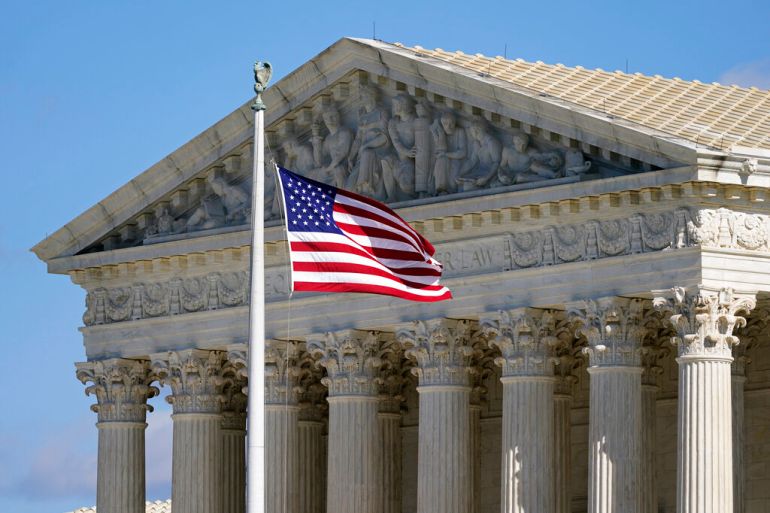US top court limits federal gov’t power to curb plant emissions
Supreme Court rules that the law does not give EPA broad authority to reduce carbon dioxide emissions from power plants.

In a blow to the fight against climate change, the US Supreme Court has limited how the nation’s main anti-air pollution law can be used to reduce planet-warming carbon dioxide emissions from power plants.
By a six-to-three decision on Thursday, with conservatives in the majority, the court said that the Clean Air Act does not give the US Environmental Protection Agency (EPA) broad authority to regulate greenhouse gas emissions from power plants that contribute to global warming.
Keep reading
list of 3 items‘My body, my choice’: Anger over US Supreme Court abortion ruling
US Supreme Court Justice Stephen Breyer to step down on Thursday
The court’s ruling could complicate the administration’s plans to combat climate change. Its proposal to regulate power plant emissions is expected by the end of the year.
President Joe Biden has aimed to cut the US’s greenhouse gas emissions in half by the end of the decade and to have an emissions-free power sector by 2035. Power plants account for roughly 30 percent of carbon dioxide output.
The justices heard arguments in the case on the same day that a United Nations panel’s report warned that the effects of climate change are about to get much worse, likely making the world sicker, hungrier, poorer and more dangerous in the coming years.
Biden called the ruling on Thursday “another devastating decision that aims to take our country backwards”, pledging to continue to take action to address the climate crisis.
“We cannot and will not ignore the danger to public health and existential threat the climate crisis poses,” the US president said in a statement. “The science confirms what we all see with our own eyes – the wildfires, droughts, extreme heat, and intense storms are endangering our lives and livelihoods.”
Stephane Dujarric, spokesperson for the United Nations Secretary-General Antonio Guterres, said the top US court’s decision was a “setback” in the fight against climate change.
“An emergency as global in nature as climate change requires a global response, and the actions of a single nation should not and cannot make or break whether we reach our climate objectives,” Dujarric said.
The US power plant case has a long and complicated history that began with the Obama administration’s Clean Power Plan. That plan would have required states to reduce emissions from the generation of electricity, mainly by shifting away from coal-fired plants.
But that scheme never took effect. Acting in a lawsuit filed by West Virginia and others, the Supreme Court blocked it in 2016 by a five-to-four vote, with conservatives in the majority.
With the plan on hold, the legal fight continued. But after President Donald Trump took office, the EPA repealed the Obama-era plan. The agency argued that its authority to reduce carbon emissions was limited and it devised a new plan that sharply reduced the federal government’s role in the issue.
New York, and 21 other mainly Democratic states, Washington, DC and some of the nation’s largest cities sued over the Trump plan. The federal appeals court in Washington ruled against both the repeal and the new plan, and its decision left nothing in effect while the new administration drafted a new policy.
Adding to the unusual nature of the high court’s involvement, the reductions sought in the Obama plan by 2030 already have been achieved through the market-driven closure of hundreds of coal plants.
Power plant operators serving 40 million people called on the court to preserve the companies’ flexibility to reduce emissions while maintaining reliable service. Prominent businesses that include Apple, Amazon, Google, Microsoft and Tesla also backed the administration.
Nineteen mostly Republican-led states and coal companies led the fight at the Supreme Court against broad EPA authority to regulate carbon output.
Thursday’s ruling was based on what is called the “major questions” legal doctrine, which requires explicit congressional authorisation for action on issues of broad importance and societal impact.
The justices in January embraced that theory when it blocked the Biden administration’s vaccine-or-test policy for larger businesses, a key element of its plan to combat the COVID-19 pandemic.
Chief Justice John Roberts wrote in the majority opinion that while a nationwide transition from using coal to produce electricity may be “sensible”, the EPA does not have the authority to force that change.
“A decision of such magnitude and consequence rests with Congress itself, or an agency acting pursuant to a clear delegation from that representative body,” Roberts wrote.
In a dissenting opinion, liberal Justice Elena Kagan argued that the Clean Air Act gives the EPA broad authority to regulate power plants’ greenhouse emissions.
“The Clean Power Plan falls within EPA’s wheelhouse, and it fits perfectly … with all the Clean Air Act’s provisions,” Kagan wrote. “That the Plan addresses major issues of public policy does not upend the analysis. Congress wanted EPA to do just that.”
The ruling on Thursday was the latest decision by the court’s conservative majority backing right-wing positions after revoking the constitutional right to abortion last week.
US Senator Tina Smith slammed the court’s ruling on Thursday, stressing that the “climate crisis is real”.
“SCOTUS just blocked necessary action to reduce power plant emissions,” Smith wrote on Twitter. “This activist court expanded gun rights, revoked reproductive rights, and now they’re siding with large polluters and conservative special interests.”